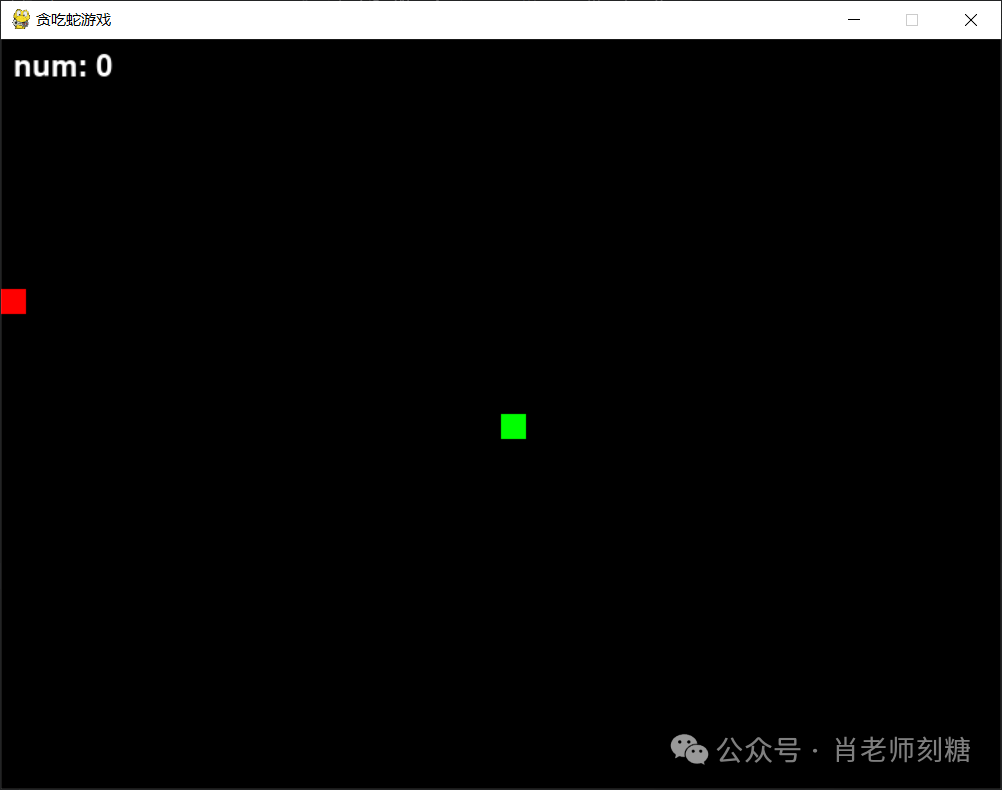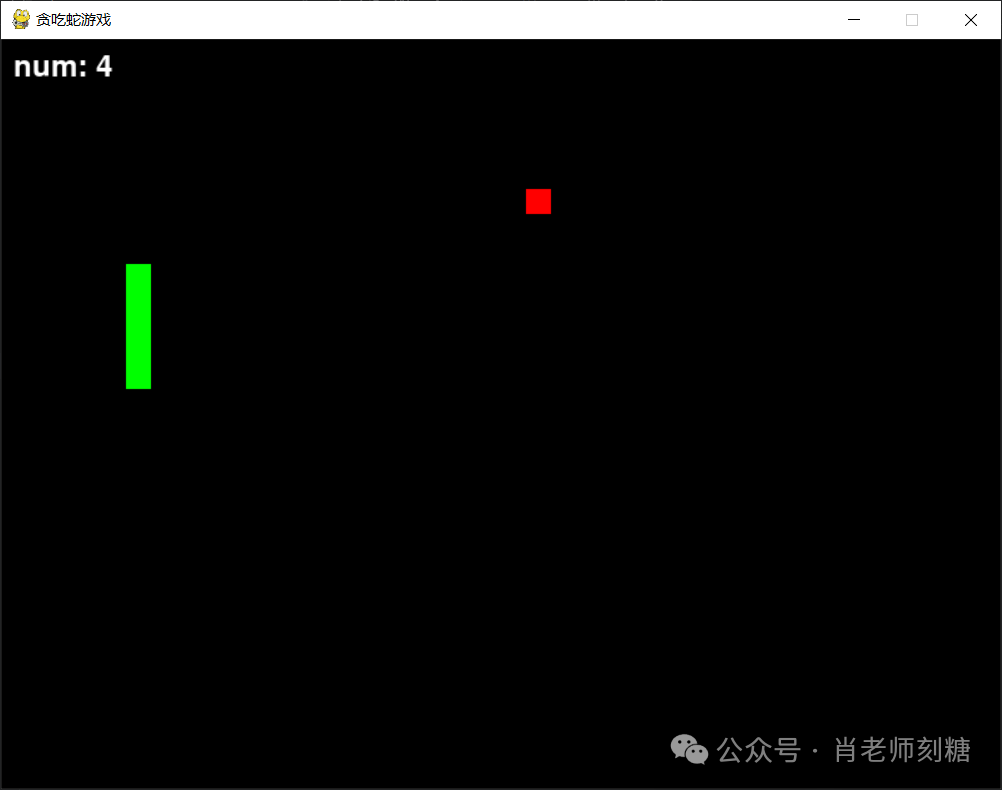

1. Preparation
Before you start writing code, you need to ensure that Python and the `pygame` library are installed. If you haven’t installed `pygame`, you can do so using the following command in the cmd terminal:
pip install pygame2. Snake Game Code
Here is the complete code:
import pygame
import random
import time
# Initialize pygame
pygame.init()
# Set window size
width = 800
height = 600
# Set colors
black = (0, 0, 0)
white = (255, 255, 255)
red = (255, 0, 0)
green = (0, 255, 0)
blue = (0, 0, 255)
# Set game window
window = pygame.display.set_mode((width, height))
pygame.display.set_caption("Snake Game")
# Set frame rate
clock = pygame.time.Clock()
snake_speed = 15
# Define snake size
snake_block = 20
# Font settings
font_style = pygame.font.SysFont(None, 50)
score_font = pygame.font.SysFont(None, 35)
def show_score(score):
"""Display score"""
value = score_font.render("nums: " + str(score), True, white)
window.blit(value, [10, 10])
def draw_snake(snake_block, snake_list):
"""Draw snake"""
for block in snake_list:
pygame.draw.rect(window, green, [block[0], block[1], snake_block, snake_block])
def message(msg, color):
"""Display message"""
mesg = font_style.render(msg, True, color)
window.blit(mesg, [width / 6, height / 3])
def game_loop():
"""Main game loop"""
game_over = False
game_close = False
# Initialize snake position and length
x1 = width / 2
y1 = height / 2
x1_change = 0
y1_change = 0
snake_list = []
length_of_snake = 1
# Food position
foodx = round(random.randrange(0, width - snake_block) / snake_block) * snake_block
foody = round(random.randrange(0, height - snake_block) / snake_block) * snake_block
while not game_over:
while game_close:
# Game over screen
window.fill(black)
message("game over! Q break or C continue", red)
show_score(length_of_snake - 1)
pygame.display.update()
# Check for key presses
for event in pygame.event.get():
if event.type == pygame.QUIT: # Check for window close event
game_over = True
game_close = False
if event.type == pygame.KEYDOWN:
if event.key == pygame.K_q:
game_over = True
game_close = False
if event.key == pygame.K_c:
game_loop()
# Check for key presses
for event in pygame.event.get():
if event.type == pygame.QUIT: # Check for window close event
game_over = True
if event.type == pygame.KEYDOWN:
if event.key == pygame.K_LEFT:
x1_change = -snake_block
y1_change = 0
elif event.key == pygame.K_RIGHT:
x1_change = snake_block
y1_change = 0
elif event.key == pygame.K_UP:
y1_change = -snake_block
x1_change = 0
elif event.key == pygame.K_DOWN:
y1_change = snake_block
x1_change = 0
# Check for collisions
if x1 >= width or x1 < 0 or y1 >= height or y1 < 0:
game_close = True
# Update snake position
x1 += x1_change
y1 += y1_change
window.fill(black)
pygame.draw.rect(window, red, [foodx, foody, snake_block, snake_block])
snake_head = []
snake_head.append(x1)
snake_head.append(y1)
snake_list.append(snake_head)
# Control snake length
if len(snake_list) > length_of_snake:
del snake_list[0]
# Check if snake collides with itself
for block in snake_list[:-1]:
if block == snake_head:
game_close = True
# Draw snake
draw_snake(snake_block, snake_list)
show_score(length_of_snake - 1)
pygame.display.update()
# Check if food is eaten
if x1 == foodx and y1 == foody:
foodx = round(random.randrange(0, width - snake_block) / snake_block) * snake_block
foody = round(random.randrange(0, height - snake_block) / snake_block) * snake_block
length_of_snake += 1
# Control frame rate
clock.tick(snake_speed)
# Exit game
pygame.quit()
quit()
# Start game
game_loop()3. Code Analysis
### Initialize the game window, creating a game window with a width of 800 pixels and a height of 600 pixels, and setting the window title.
window = pygame.display.set_mode((width, height))
pygame.display.set_caption("Snake Game")### Set colors, defining some commonly used colors for later use.
black = (0, 0, 0)
white = (255, 255, 255)
red = (255, 0, 0)
green = (0, 255, 0)
blue = (0, 0, 255)### Snake movement and control, this part of the code listens for keyboard events and updates the snake’s movement direction based on the player’s key presses.
for event in pygame.event.get():
if event.type == pygame.KEYDOWN:
if event.key == pygame.K_LEFT:
x1_change = -snake_block
y1_change = 0
elif event.key == pygame.K_RIGHT:
x1_change = snake_block
y1_change = 0
elif event.key == pygame.K_UP:
y1_change = -snake_block
x1_change = 0
elif event.key == pygame.K_DOWN:
y1_change = snake_block
x1_change = 0### Food generation, using the `random` module to randomly generate the food’s position, ensuring that the food does not appear on the snake’s body.
foodx = round(random.randrange(0, width - snake_block) / snake_block) * snake_block
foody = round(random.randrange(0, height - snake_block) / snake_block) * snake_block### Collision detection, checking if the snake collides with the walls. If it does, the game ends.
if x1 >= width or x1 < 0 or y1 >= height or y1 < 0:
game_close = True### Check if the snake collides with its own body. If it does, the game ends.
for block in snake_list[:-1]:
if block == snake_head:
game_close = True### Score display, displaying the current score in the top left corner of the game window.
def show_score(score):
value = score_font.render("Score: " + str(score), True, white)
window.blit(value, [10, 10])The source code for this lesson is available in the group materials of the study group. Follow the public account and reply with “study” to join the group and receive the source code for this lesson’s case.